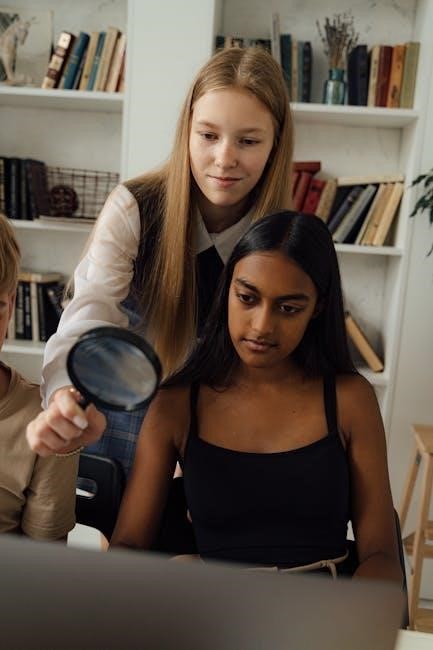Good Girl, Bad Blood is the highly anticipated sequel to Holly Jackson’s bestselling A Good Girl’s Guide to Murder. It follows Pip Fitz-Amobi, now a true-crime podcast host, as she uncovers dark secrets in her town when a friend goes missing, drawing her back into detective work despite her vows to stop. This gripping, true-crime fueled mystery continues the story of Pip’s relentless pursuit of justice, blending twists and suspense with a deep dive into her town’s hidden truths.
Overview of the Book
Good Girl, Bad Blood is a gripping crime-thriller and the second installment in Holly Jackson’s A Good Girl’s Guide to Murder series. Following the events of the first book, Pip Fitz-Amobi has retired from detective work and now hosts a viral true-crime podcast about the murder case she and Ravi Singh solved. However, her quiet life is disrupted when her friend Jamie Reynolds goes missing during a memorial for the victims of a past tragedy. With the police unresponsive, Pip reluctantly returns to investigative work, uncovering more dark secrets about her town. The book is praised for its addictive, true-crime-inspired narrative and its exploration of themes like justice, morality, and the pressures of fame. At 416 pages, it continues the series’ tradition of blending suspense, twists, and relatable characters, solidifying its place as a must-read for fans of young adult mystery and thriller genres.
Background of the Series
The A Good Girl’s Guide to Murder series, written by Holly Jackson, is a young adult mystery-thriller phenomenon that has captivated readers worldwide. The first book, released in 2019, became an instant bestseller and won the British Book Awards’ Children’s Book of the Year in 2020. Its success led to the creation of a trilogy, with Good Girl, Bad Blood as the second installment, followed by As Good as Dead. The series follows protagonist Pip Fitz-Amobi, a determined and resourceful teenager, as she navigates murder mysteries, dark secrets, and personal growth. Known for its true-crime inspired narratives and relatable characters, the series has gained a massive following, particularly among young adults. It has also been adapted into a Netflix series, further amplifying its cultural impact. Holly Jackson’s writing style, blending suspense with witty dialogue, has established her as a prominent voice in the thriller genre.
Key Themes and Motifs
Good Girl, Bad Blood explores themes of identity, morality, and the blurred lines between good and evil. Pip Fitz-Amobi’s journey delves into her internal struggle to balance her desire for justice with the ethical boundaries she once vowed to uphold. The novel highlights the weight of secrets and the lasting impact of past events on present lives. True-crime obsession and the influence of social media are central motifs, as Pip’s podcast gains viral attention, drawing her into a deadly investigation. The story also examines themes of friendship, loyalty, and resilience, as Pip faces increasing pressure and danger while uncovering her town’s hidden truths. Holly Jackson’s writing weaves these elements into a gripping narrative that challenges readers to question their perceptions of justice and accountability.

Plot Summary
Good Girl, Bad Blood follows Pip Fitz-Amobi as she investigates the disappearance of her friend Jamie Reynolds, uncovering dark secrets in her town and confronting new deadly threats, all while navigating her viral true-crime podcast.

Main Plot Points

The story begins with Pip Fitz-Amobi, now a viral true-crime podcast host, attempting to move past her detective days. However, her life is disrupted when her friend Jamie Reynolds disappears during a memorial for Andie Bell and Sal Singh. The police refuse to investigate, prompting Pip to take matters into her own hands. As she delves deeper, she uncovers dark secrets about her town’s history and the people she trusts. The podcast’s popularity adds pressure, as everyone listens to her investigation unfold in real-time. Pip’s search for Jamie reveals lies, betrayals, and a web of deceit that threatens to destroy lives. The trial of Max Hastings, a key figure from the first book, adds another layer of tension, as his acquittal sparks outrage. Pip’s relentless pursuit of the truth puts her in grave danger, testing her courage and resolve.
Character Development
Pip Fitz-Amobi evolves significantly in Good Girl, Bad Blood, as she navigates the pressures of her viral podcast and the resurgence of her investigative instincts. Her determination to uncover the truth about Jamie Reynolds’ disappearance showcases her unwavering resolve, despite the personal risks involved. Ravi Singh remains a steadfast ally, offering emotional and practical support, while their bond deepens. New characters are introduced, adding layers to the story, and familiar faces from the first book return, revealing more about their motivations. Pip’s growth is evident as she balances her podcast’s influence with the weight of her responsibilities. The novel also explores the moral complexities of her actions, highlighting her struggle to remain ethical in the face of intense scrutiny. Through her journey, Pip emerges as a stronger, more resilient character, ready to confront the dark secrets of her town head-on.
Climax and Resolution

The climax of Good Girl, Bad Blood unfolds as Pip races against time to find Jamie Reynolds before it’s too late; Her investigation exposes shocking secrets tied to the town’s history, including the unresolved case of Andie Bell and Sal Singh. The trial of Max Hastings adds another layer of tension, as the jury’s verdict sparks outrage and disbelief. Pip’s relentless pursuit of the truth puts her in grave danger, forcing her to confront the darkest corners of her town. The resolution ties together the tangled threads of the mystery, revealing a chilling truth about Jamie’s disappearance. Pip’s actions have far-reaching consequences, not only for her but also for those around her. The book concludes on a suspenseful note, leaving readers eager for the next installment, As Good as Dead, while highlighting Pip’s growth and the enduring impact of her quest for justice.

Reception and Impact
Good Girl, Bad Blood became a New York Times bestseller, praised for its gripping narrative and true-crime elements. It has sold millions worldwide, solidifying Holly Jackson’s status as a leading thriller author. The book’s success led to a Netflix adaptation, expanding its reach and cementing its impact on young adult literature.
Reviews and Ratings
Good Girl, Bad Blood has garnered widespread acclaim, with a 4.5-star rating on Amazon from over 31,830 reviews, praising its addictive, true-crime fueled narrative. Critics and readers alike have lauded Holly Jackson’s masterful storytelling, with many highlighting the book’s ability to keep readers on the edge of their seats. The Guardian described it as “nail-biting, taut, and pacy,” while fans have praised Pip Fitz-Amobi’s relentless determination and the deeper exploration of her town’s dark secrets. The book’s success is further evidenced by its status as a New York Times bestseller and its inclusion in the multimillion bestselling A Good Girl’s Guide to Murder series. With its gripping plot and well-developed characters, Good Girl, Bad Blood has solidified its place as a must-read in the young adult thriller genre.
Awards and Recognition
Good Girl, Bad Blood, the second installment in Holly Jackson’s A Good Girl’s Guide to Murder series, has achieved remarkable recognition in the literary world. The series as a whole has been a global sensation, with millions of copies sold worldwide. The first book, A Good Girl’s Guide to Murder, won the prestigious British Book Awards Children’s Book of the Year 2020 and was shortlisted for the Waterstones Children’s Book Prize 2020. The sequel has continued this success, becoming a New York Times bestseller and solidifying Jackson’s reputation as a masterful thriller writer. The series has also been adapted into a highly anticipated Netflix production, further cementing its impact on popular culture. These accolades highlight the series’ ability to captivate readers and critics alike with its gripping mysteries and unforgettable characters.
Cultural and Social Impact
Good Girl, Bad Blood has left a significant mark on popular culture, resonating with readers worldwide. As part of the A Good Girl’s Guide to Murder series, it has sparked conversations about true crime, morality, and female empowerment. The book’s relatable protagonist, Pip Fitz-Amobi, has become a cultural icon, inspiring young readers with her determination and wit. Its exploration of dark secrets and small-town mysteries has captivated audiences, particularly teenagers, who see themselves in Pip’s struggles and triumphs. The series’ adaptation into a Netflix production has further amplified its reach, turning it into a cultural phenomenon. By blending gripping storytelling with socially relevant themes, Good Girl, Bad Blood has not only entertained but also influenced the way young people engage with mystery and crime narratives, solidifying its place as a modern classic in the genre.
